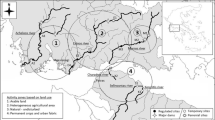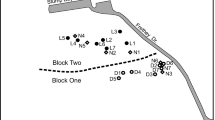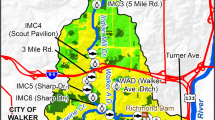Abstract
We examined the influence of land-use, habitat, and water quality on the spatial distribution of aquatic macroinvertebrates in two human-dominated catchments in the Swiss Plateau (Gürbe, Mönchaltorfer Aa). Land-use in the Gürbe catchment was dominated by agriculture, whereas urban land-use was more common in the Mönchaltorfer Aa. Study sites in each catchment were characterized using measures of local habitat conditions, water quality parameters including water temperature, and organic matter resources. A strong longitudinal gradient in temperature, conductivity and nitrogen was evident among sites in the Gürbe catchment, although sites on a main tributary had a strong agricultural signature and deviated from this pattern. Percentage agricultural land-use in the Gürbe was strongly correlated with algal biomass and the water quality PCA axes associated with conductivity, nitrogen (axis-1) and temperature (axis-3). Spatial grouping of sites by water quality was less evident in the Mönchaltorfer Aa, except for a strong signal by wastewater treatment plant effluents and partial differences between upper and lower basin sites. Percentage forest and agricultural land-use in the Mönchaltorfer Aa were correlated with water quality PCA axis-2, being associated with phosphorus and temperature. Macroinvertebrate densities, taxonomic richness, and axis-1 from a non-metric multidimensional scaling analysis (NMDS) of taxonomic composition were significantly correlated with water quality PCA axis-1 in the Gürbe catchment. Here, macroinvertebrate densities and NMDS axis-1 scores based on taxon relative abundances and densities were correlated with land-use features. Spatial distances between sites also were related to site differences in macroinvertebrates, reflecting the strong longitudinal environmental gradient in the Gürbe. Taxonomic differences between water quality PCA site groups were less pronounced in the Mönchaltorfer Aa, although differences were significant for trichopterans, ephemeropterans, chironomids, gastropods and coleopterans. Here, NMDS axis-1 based on taxon relative abundances and densities was correlated with forest land-use. Spatial distances between sites were not evident in macroinvertebrate site differences, reflecting the less pronounced spatial and longitudinal patterns in environmental attributes in this catchment. Our results support the hypothesis that spatial distributions of macroinvertebrates are related to spatial relationships among environmental attributes like land-use, habitat, and water quality in human-dominated catchments that depend on river network complexity, a habitat-filtering template in line with ecological niche theory.





Similar content being viewed by others
References
Allan JD (2004) Landscapes and riverscapes: the influence of land use on stream ecosystems. Annu Rev Ecol Evol Syst 35:257–284
Allan JD, Castillo MM (2007) Stream ecology: structure and function of running waters, 2nd edn. Springer, The Netherlands
Allan JD, Erickson DL, Fay J (1997) The influence of catchment land use on stream integrity across multiple spatial scales. Freshw Biol 37:149–161
Amoros C, Bornette G (2002) Connectivity and biocomplexity in waterbodies of riverine floodplains. Freshw Biol 47:761–776
Bernot MJ, Sobota DJ, Hall RO, Mulholland PJ, Dodds WK, Webster JR, Tank JL, Ashkenas LR, Cooper LW, Dahm CN, Gregory SV, Grimm NB, Hamilton SK, Johnson SL, McDowell WH, Meyer JL, Peterson B, Poole GC, Valett HM, Arango C, Beaulieu JJ, Burgin AJ, Crenshaw C, Helton AM, Johnson L, Merriam J, Niederlehner BR, O’Brien JM, Potter JD, Sheibley RW, Thomas SM, Wilson K (2010) Inter-regional comparison of land-use effects on stream metabolism. Freshw Biol 55:1874–1890
Brierley GJ, Cohen T, Fryirs K, Brooks A (1999) Post-European changes to the fluvial geomorphology of Bega catchment, Australia: implications for river ecology. Freshw Biol 41:839–848
Bundi U, Peter A, Frutiger A, Hütte M, Liechti P, Sieber U (2000) Scientific base and modular concept for comprehensive assessment of streams in Switzerland. Hydrobiologia 422(423):477–487
Busse LB, Simpson JC, Cooper SD (2006) Relationships among nutrients, algae, and land use in urbanized southern California streams. Can J Fish Aquat Sci 63:2621–2638
Carr GM, Chambers PA, Morin A (2005) Periphyton, water quality, and land use at multiple spatial scales in Alberta rivers. Can J Fish Aquat Sci 62:1309–1319
Dodds WK (2008) Humanity’s footprint: momentum, impact, and our global environment. Columbia University Press, New York
Frissell CA, Liss WJ, Warren CE, Hurley MD (1986) A hierarchical framework for stream habitat classification: viewing streams in a watershed context. Environ Manage 12:199–214
Hanke I, Wittmer IK, Bischofberger S, Stamm C, Singer H (2010) Relevance of urban glyphosate use for surface water quality. Chemosphere 81:422–429
Harding JS, Benfield EF, Bolstad PV, Helfman GS, Jones EBD (1998) Stream biodiversity: the ghost of land use past. Proc Nat Acad Sci USA 95:14843–14847
King RS, Baker ME, Whigham DF, Weller DE, Jordan TE, Kazyak PF, Hurd MK (2005) Spatial considerations for linking watershed land cover to ecological indicators in streams. Ecol Appl 15:137–153
Klose K, Cooper SD, Leydecker AD, Kreitler J (2012) Relationships among catchment land use and concentrations of nutrients, algae, and dissolved oxygen in a southern California river. Freshw Sci 31:908–927
Liechti P. (2010) Methoden zur Untersuchung und Beurteilung der Fliessgewässer. Chemisch-physikalische Erhebungen, Nährstoffe. Umwelt-Vollzug Nr. 1005. Bundesamt für Umwelt, Bern, Switzerland
Liess A, Le Gros A, Wagenhoff A, Townsend CR, Matthaei CD (2012) Landuse intensity in stream catchments affects the benthic food web: consequences for nutrient supply, periphyton C: nutrient ratios, and invertebrate richness and abundance. Freshw Sci 31:813–824
Matson PA, Parton WJ, Power AG, Swift MJ (1997) Agricultural intensification and ecosystem properties. Science 277:504–509
Matthaei CD, Piggitt JJ, Townsend CD (2010) Multiple stressors in agricultural streams: interactions among sediment addition, nutrient enrichment and water abstraction. J Appl Ecol 47:639–649
Merritt RW, Cummins KW (1984) An introduction to the aquatic insects of North America. Kendall/Hunt Publishing Company, Iowa
Meyer WB, Turner BL (1994) Changes in land use and land cover: a global perspective. Cambridge University Press, New York
Mykrä H, Heino J, Muotka T (2007) Scale-related patterns in the spatial and environmental components of stream macroinvertebrate assemblage variation. Glob Ecol Biogeogr 16:149–159
Niyogi DK, Koren M, Arbuckle CJ, Townsend CR (2007) Stream communities along a catchment land-use gradient: subsidy-stress responses to pastoral development. Environ Manage 39:213–225
Norris RH, Thoms MC (1999) What is river health? Freshw Biol 41:197–209
Odzak N, Kistler D, Xue HB, Sigg L (2002) In situ trace metal speciation in a eutrophic lake using the technique of diffusion gradients in thin films (DGT). Aquat Sci 64:292–299
Poff NL (1997) Landscape filters and species traits: towards mechanistic understanding and prediction in stream ecology. J N Am Benthol Soc 16:391–409
Quinn JM (2000) Effects of pastoral development. In: Collier KJ, Winterbourn MJ (eds) New Zealand stream invertebrates: ecology and implications for management. Caxton, Christchurch, pp 208–229
R Development Core Team (2011) R: A language and environment for statistical computing. R Foundation for Statistical Computing, Vienna, Austria. ISBN 3-900051-07-0, http://www.R-project.org/
Richards C, Johnson LB, Host GE (1996) Landscape-scale influences on stream habitats and biota. Can J Fish Aquat Sci 53:295–311
Richards C, Haro RJ, Johnson LB, Host GE (1997) Catchment and reach-scale properties as indicators of macroinvertebrate species traits. Freshw Biol 37:219–230
Singer H, Jaus S, Hanke I, Lück A, Holleder J, Alder AC (2010) Determination of biocides and pesticides by on-line solid phase extraction coupled with mass spectrometry and their behaviour in wastewater and surface water. Environ Pollut 158:3054–3064
Southwood TRE (1988) Tactics, strategies, and templets. Oikos 52:3–18
Sponseller RA, Benfield EF, Valett HM (2001) Relationships between land use, spatial scale and stream macroinvertebrate communities. Freshw Biol 46:1409–1424
Stamm C, Ochsenbein U, Berset JD, Siber R, Scheiwiller E, Singer H, Muff D (2012) Ereignisbezogenes Pestizidmonitoring am Beispiel der Gürbe (Kanton Bern). Aqua Gas 4:24–32
Strayer DL, Beighley RE, Thompson LC, Brooks S, Nilsson C, Pinay G, Naiman RJ (2003) Effects of land cover on stream ecosystems: roles of empirical models and scaling issues. Ecosystems 6:407–423
Thompson R, Townsend CR (2006) A truce with neutral theory: local deterministic factors, species traits and dispersal limitation together determine patterns of diversity in stream invertebrates. J Anim Ecol 75:476–484
Tockner K, Malard F, Burgherr P, Robinson CT, Uehlinger U, Zah R, Ward JV (1997) Characteristics of channel types in a glacial floodplain ecosystem (Val Roseg, Switzerland). Archiv für Hydrobiologie 140:433–463
Vannote RL, Minshall GW, Cummins KW, Sedell JR, Cushing CE (1980) The river continuum concept. Can J Fish Aquat Sci 37:130–137
Vermeirssen ELM, Dietschweiler C, Escher BI, Van Der Voet J, Hollender J (2012) Transfer kinetics of polar organic compounds over polyethersulfone membranes in the passive samplers pocis and chemcatcher. Environ Sci Technol 46:6759–6766
Wagenhoff A, Townsend CR, Phillips N, Matthaei CD (2011) Subsidy-stress and multiple-stressor effects along gradients of deposited fine sediment and dissolved nutrients in a regional set of streams and rivers. Freshw Biol 56:1916–1936
Walsh CJ, Kunapo J (2009) The importance of upland flow paths in determining urban effects on stream ecosystems. J N Am Benthol Soc 28:977–990
Wassen JG, Villeneuve B, Iital A, Murray-Bligh J, Dobiasova M, Bacikova S, Timm H, Pella H, Mengin N, Chandesris A (2010) Large-scale relationships between basin and riparian land cover and the ecological status of European rivers. Freshw Biol 55:1465–1482
Wittmer IK, Bader HP, Scheidegger R, Singer H, Lück A, Hanke I, Carlsson C, Stamm C (2010) Significance of urban and agricultural land use for biocide and pesticide dynamics in surface waters. Water Res 44:2850–2862
Wittmer IK, Bader HP, Scheidegger R, Singer H, Stamm C (2011) Loss rates of urban biocides can exceed those of agricultural pesticides. Sci Total Environ 409:920–932
Zar JH (1984) Biostatistical analysis, 2nd edn. Prentice Hall, Englewood Cliffs
Zhang H, Davison W (1995) Performance characteristics of diffusion gradients in thin films for the in situ measurement of trace metals in aqueous solution. Anal Chem 67:3391–3400
Acknowledgments
The authors graciously thank C. Jolidon, A. Lück, M. Scheurer and N. Ghielmetti for assistance in the field and laboratory processing of samples. We thank the Aua Lab of Eawag for completing the water chemistry analyses. A. Lück and H. Singer carried out the analyses of the organic micropollutants, D. Kistler analysed the heavy metal measurements and M. Zennegg the PCBs. E. Vermeirssen and N. Odzak provided valuable support for the passive sampling. We thank R. Siber for GIS support and map illustrations. We thank two anonymous reviewers that provided helpful comments that improved the paper presentation. The project was funded by the Swiss National Science Foundation (No. 4061-40_125866/1).
Author information
Authors and Affiliations
Corresponding author
Electronic supplementary material
Below is the link to the electronic supplementary material.
Electronic supplementary material
Below is the link to the electronic supplementary material.
Fig. S1: Correlation between dissimilarities of environmental factors between sites in the Gürbe catchment.
Fig. S2: Correlation between dissimilarities of environmental factors between sites in the Mönchaltorfer Aa catchment.
Fig. S3: Comparison of the observed taxonomic distance between sites (x-axis) and the predicted values (y-axis) based on linear models for all combinations of environmental factors in the Gürbe catchment. The black points represent the full model including all environmental factors, red points represent the 3-factor models, blue the 2-factor models, and green the single factor models. Tax: taxonomic distance in the Gürbe, Dist: physical distance in the stream network Hab: Habitat, qual: dist:, Use: land use, WQ: water quality.
Fig. S4: Comparison of the observed taxonomic distance between sites (x axis) and the predicted values (y axis) based on linear models for all combinations of environmental factors in the Mönchaltorfer Aa catchment (all 14 sites). The black points represent the full model including all environmental factors, red points represent the 3-factor models, blue the 2-factor models, and green the single factor models. Tax: taxonomic distance in the Gürbe, Dist: physical distance in the stream network Hab: Habitat, qual: dist:, Use: land use, WQ: water quality.
Rights and permissions
About this article
Cite this article
Robinson, C.T., Schuwirth, N., Baumgartner, S. et al. Spatial relationships between land-use, habitat, water quality and lotic macroinvertebrates in two Swiss catchments. Aquat Sci 76, 375–392 (2014). https://doi.org/10.1007/s00027-014-0341-z
Received:
Accepted:
Published:
Issue Date:
DOI: https://doi.org/10.1007/s00027-014-0341-z




